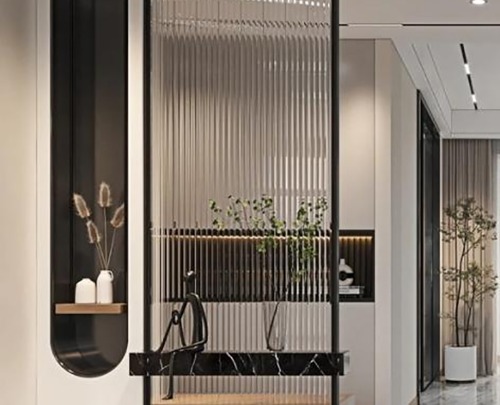Acrylic reeded glass, also known as textured acrylic glass, finds various applications in both residential and commercial settings. The unique texture and appearance of reeded glass make it a popular choice for enhancing privacy, diffusing light, and adding aesthetic appeal to interior and exterior spaces. Here are some common applications of acrylic reeded glass:
Doors and Windows:
Acrylic reeded glass is frequently used in doors and windows to provide privacy while allowing natural light to pass through.
It is often used in bathroom doors, shower enclosures, and windows where privacy is desired without sacrificing light transmission.
Room Dividers and Partitions:
Acrylic reeded glass is used to create room dividers and partitions in interior spaces.
The textured surface adds visual interest and can separate areas while maintaining a sense of openness and natural light flow.
Cabinet Doors and Shelving:
Acrylic reeded glass is commonly used for cabinet doors and shelving in kitchens, bathrooms, and display cabinets.
It adds a decorative element while partially concealing the contents and diffusing light for an elegant display.
Decorative Panels and Backsplashes:
Acrylic reeded glass is employed as decorative panels in various applications, such as wall coverings and backsplashes.
Its distinctive texture adds a unique visual appeal and can be combined with lighting to create captivating design features.
Retail and Commercial Spaces:
Acrylic reeded glass is utilized in retail stores, offices, and commercial establishments to create partitions, display cases, and decorative elements.
It offers a combination of privacy, aesthetics, and light diffusion, making it suitable for various commercial applications.
Lighting Fixtures:
Acrylic reeded glass is used in lighting fixtures, including pendant lights, wall sconces, and lampshades.
The textured surface enhances the visual interest of the light output, creating a diffused and softened illumination effect.
Furniture:
Acrylic reeded glass can be incorporated into furniture design, such as tabletops, cabinet inserts, and decorative accents.
It adds a modern touch and can complement different styles of furniture.
Architectural Features:
Acrylic reeded glass is utilized in architectural features, such as stair railings, balustrades, and wall cladding.
It adds texture, diffuses light, and contributes to the overall aesthetic appeal of the space.
Acrylic reeded glass offers a versatile and decorative solution for various applications where privacy, light diffusion, and aesthetic enhancement are desired. Its durable and lightweight nature, along with its distinct texture, makes it a popular choice in both residential and commercial design.Besides,Acrylic reeded glass, also known as textured acrylic glass, is a type of glass that has a unique textured surface. The production process involves several steps to create the desired reeded pattern. Here is a general overview of the production steps involved:
Preparation of the Glass Sheet:
The production starts with a flat glass sheet, which can be made of acrylic or other types of glass.
The glass sheet is cleaned and prepared to ensure a smooth and even surface.
Application of the Reeding Material:
A liquid or gel reeding material is applied to the surface of the glass sheet.
The reeding material is typically a special resin or lacquer that can create the desired texture when cured or dried.
Formation of the Reeded Pattern:
The reeding material is manipulated or processed to create the textured pattern.
Various techniques can be used, such as rolling a reeding roller over the glass sheet or using a mold or template to press the pattern onto the surface.
The reeding material may be shaped into vertical or horizontal lines, grooves, or other desired patterns.
Curing or Drying:
After the reeding material is applied and the pattern is formed, it needs to cure or dry.
The curing process can involve the application of heat or exposure to ultraviolet (UV) light, depending on the specific reeding material used.
Curing or drying solidifies the reeding material, creating a permanent textured pattern on the glass surface.
Finishing and Quality Control:
Once the reeding material is fully cured or dried, the glass sheet undergoes finishing processes.
Finishing may involve cutting the glass sheet to the desired size, smoothing the edges, and inspecting the quality of the reeded pattern.
Quality control measures are taken to ensure that the texture is consistent, and the glass sheet meets the desired standards.
Packaging and Distribution:
The finished acrylic reeded glass sheets are carefully packaged to protect them during transportation.
They are then distributed to retailers, manufacturers, or other customers for further processing or direct use in various applications.
It's important to note that the specific production steps and techniques used in the manufacturing of acrylic reeded glass can vary among manufacturers. Some manufacturers may have proprietary methods or additional steps to create specific textures or patterns. The quality and appearance of the final product depend on the precision and expertise of the manufacturing process.

 English
English 中文
中文 Español
Español


